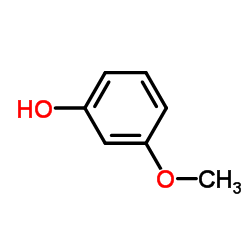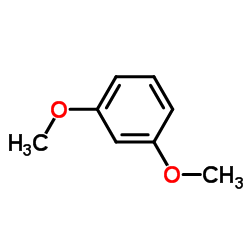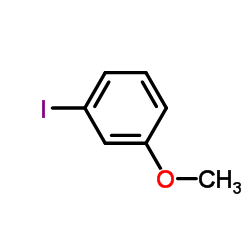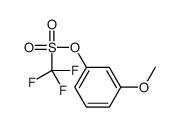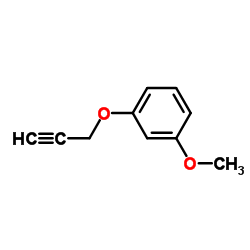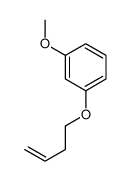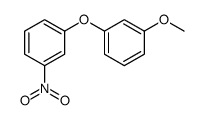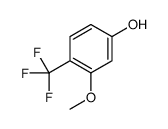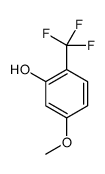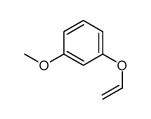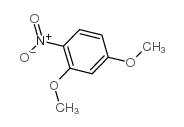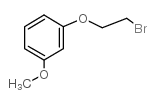150-19-6
| 中文名 | 3-甲氧基苯酚 |
|---|---|
| 英文名 | 3-methoxyphenol |
| 中文别名 |
间甲氧基苯酚
间羟基苯甲醚 间甲氧基酚 3-甲氧基酚 间苯二酚单甲醚 3-羟基苯甲醚 |
| 英文别名 |
m-Hydroxyanisole
Resorcinol methyl ether m-Guaiacol 3-methoxy phenol 1-Hydroxy-3-methoxybenzene 3-Methoxy-phenol Resorcinol monomethyl ether 1,3-dihydroxybenzene monomethyl ether Phenol,3-methoxy m-Hydroxyanisol 3-Methoxyphenol m-Methoxyphenol 3-hydroxyanisole EINECS 205-754-6 methyl resorcinol MFCD00002267 |
| 描述 | 3-Methoxyphenol 是一种酚类化合物,具有生物毒性。3-Methoxyphenol 可被全身吸收性,扰乱肝脏、肾脏、中枢神经系统和氧化还原过程的功能,并增加体内 Hb、红细胞和白细胞的水平。 |
|---|---|
| 相关类别 |
| 密度 | 1.1±0.1 g/cm3 |
|---|---|
| 沸点 | 244.3±0.0 °C at 760 mmHg |
| 熔点 | -17 °C |
| 分子式 | C7H8O2 |
| 分子量 | 124.137 |
| 闪点 | 119.1±4.8 °C |
| 精确质量 | 124.052429 |
| PSA | 29.46000 |
| LogP | 1.51 |
| 外观性状 | 透明粉红色至红色液体带有苯酚的气味 |
| 蒸汽压 | 0.0±0.5 mmHg at 25°C |
| 折射率 | 1.535 |
| 储存条件 | 密封于干燥阴凉处保存。 |
| 稳定性 | 1. 常温常压下稳定。 2. 存在于香料烟烟叶、烟气中。 3. 天然存在于芸香油、芹菜子油、烟叶油、橙叶蒸馏液和海狸香中。 |
| 水溶解性 | slightly soluble |
| 分子结构 | 五、分子性质数据: 1、 摩尔折射率:34.81 2、 摩尔体积(cm3/mol):111.8 3、 等张比容(90.2K):278.9 4、 表面张力(dyne/cm):38.6 5、 极化率(10-24cm3):13.80 |
| 计算化学 | 1.疏水参数计算参考值(XlogP):无 2.氢键供体数量:1 3.氢键受体数量:2 4.可旋转化学键数量:1 5.互变异构体数量:3 6.拓扑分子极性表面积29.5 7.重原子数量:9 8.表面电荷:0 9.复杂度:83 10.同位素原子数量:0 11.确定原子立构中心数量:0 12.不确定原子立构中心数量:0 13.确定化学键立构中心数量:0 14.不确定化学键立构中心数量:0 15.共价键单元数量:1 |
| 更多 | 一、物性数据: 1. 性状:无色透明到淡黄色晶体,具有类似苯酚的甜香香气。暴露空气易变色。 2. 密度(g/mL,20℃):1.145 3. 熔点(ºC):<-17 4. 沸点(ºC,常压):243~246, 114ºC(666.5pa) 5. 折射率 (n 20 D) :1.551 6. 闪点(ºC):>112 7. 溶解性:微溶于水,溶于乙醇等有机溶剂中。8. 相对密度(20℃,4℃):1.115156 9. 相对密度(25℃,4℃):1.052131 10. 常温折射率(n 20):1.5510 |
Synonym:m-Hydroxyanisol Section 2 - COMPOSITION, INFORMATION ON INGREDIENTS
Risk Phrases: 20/21/22 36 Section 3 - HAZARDS IDENTIFICATION EMERGENCY OVERVIEW
Harmful by inhalation, in contact with skin and if swallowed. Irritating to eyes. Potential Health Effects Eye: Causes severe eye irritation. Skin: May cause skin irritation. Harmful if absorbed through the skin. May cause skin discoloration. Ingestion: May cause irritation of the digestive tract. May be harmful if swallowed. Inhalation: May cause respiratory tract irritation. Chronic: Chronic exposure may cause visual disturbances. Section 4 - FIRST AID MEASURES Eyes: Immediately flush eyes with plenty of water for at least 15 minutes, occasionally lifting the upper and lower eyelids. Get medical aid immediately. Skin: Get medical aid. Immediately flush skin with plenty of water for at least 15 minutes while removing contaminated clothing and shoes. Ingestion: If victim is conscious and alert, give 2-4 cupfuls of milk or water. Never give anything by mouth to an unconscious person. Get medical aid. Inhalation: Remove from exposure and move to fresh air immediately. Get medical aid if cough or other symptoms appear. Notes to Physician: Section 5 - FIRE FIGHTING MEASURES General Information: As in any fire, wear a self-contained breathing apparatus in pressure-demand, MSHA/NIOSH (approved or equivalent), and full protective gear. Extinguishing Media: Water or foam may cause frothing. Use water spray, dry chemical, carbon dioxide, or chemical foam. Section 6 - ACCIDENTAL RELEASE MEASURES General Information: Use proper personal protective equipment as indicated in Section 8. Spills/Leaks: Absorb spill with inert material (e.g. vermiculite, sand or earth), then place in suitable container. Section 7 - HANDLING and STORAGE Handling: Wash thoroughly after handling. Use only in a well-ventilated area. Do not get in eyes, on skin, or on clothing. Keep container tightly closed. Avoid ingestion and inhalation. Storage: Store in a tightly closed container. Store in a cool, dry, well-ventilated area away from incompatible substances. Section 8 - EXPOSURE CONTROLS, PERSONAL PROTECTION Engineering Controls: Use adequate ventilation to keep airborne concentrations low. Exposure Limits CAS# 150-19-6: Russia: 0.5 mg/m3 TWA Personal Protective Equipment Eyes: Wear appropriate protective eyeglasses or chemical safety goggles as described by OSHA's eye and face protection regulations in 29 CFR 1910.133 or European Standard EN166. Skin: Wear appropriate protective gloves to prevent skin exposure. Clothing: Wear appropriate protective clothing to prevent skin exposure. Respirators: Follow the OSHA respirator regulations found in 29 CFR 1910.134 or European Standard EN 149. Use a NIOSH/MSHA or European Standard EN 149 approved respirator if exposure limits are exceeded or if irritation or other symptoms are experienced. Section 9 - PHYSICAL AND CHEMICAL PROPERTIES Physical State: Liquid Color: clear pink red Odor: Odor of caramel and phenol pH: Not available. Vapor Pressure: Not available. Viscosity: Not available. Boiling Point: 243 - 246 deg C @ 760.00mm Hg Freezing/Melting Point: -17 deg C Autoignition Temperature: Not available. Flash Point: > 112 deg C (> 233.60 deg F) Explosion Limits, lower: Not available. Explosion Limits, upper: Not available. Decomposition Temperature: Solubility in water: soluble in water Specific Gravity/Density: 1.1310g/cm3 Molecular Formula: C7H8O2 Molecular Weight: 124.14 Section 10 - STABILITY AND REACTIVITY Chemical Stability: Stable under normal temperatures and pressures. Conditions to Avoid: Incompatible materials. Incompatibilities with Other Materials: Bases - acid chlorides - acid anhydrides - oxidizing agents. Hazardous Decomposition Products: Carbon monoxide, carbon dioxide. Hazardous Polymerization: Will not occur. Section 11 - TOXICOLOGICAL INFORMATION RTECS#: CAS# 150-19-6: SL7524000 LD50/LC50: CAS# 150-19-6: Draize test, rabbit, eye: 5% Severe; Draize test, rabbit, eye: 100%; Draize test, rabbit, skin: 100%; Inhalation, mouse: LC50 = 11500 mg/m3/4H; Inhalation, rat: LC50 = 11500 mg/m3/4H; Oral, mouse: LD50 = 312 mg/kg; Oral, mouse: LD50 = 312 mg/kg; Oral, rat: LD50 = 597 mg/kg; Oral, rat: LD50 = 597 mg/kg; Skin, rat: LD50 = 682 mg/kg. Carcinogenicity: 3-METHOXYPHENOL - Not listed by ACGIH, IARC, or NTP. Other: See actual entry in RTECS for complete information. Section 12 - ECOLOGICAL INFORMATION Section 13 - DISPOSAL CONSIDERATIONS Dispose of in a manner consistent with federal, state, and local regulations. Section 14 - TRANSPORT INFORMATION IATA Not regulated as a hazardous material. IMO Not regulated as a hazardous material. RID/ADR Not regulated as a hazardous material. Section 15 - REGULATORY INFORMATION European/International Regulations European Labeling in Accordance with EC Directives Hazard Symbols: XN Risk Phrases: R 20/21/22 Harmful by inhalation, in contact with skin and if swallowed. R 36 Irritating to eyes. Safety Phrases: S 23 Do not inhale gas/fumes/vapour/spray. S 24/25 Avoid contact with skin and eyes. WGK (Water Danger/Protection) CAS# 150-19-6: No information available. Canada CAS# 150-19-6 is listed on Canada's NDSL List. CAS# 150-19-6 is listed on Canada's Ingredient Disclosure List. US FEDERAL TSCA CAS# 150-19-6 is listed on the TSCA inventory. SECTION 16 - ADDITIONAL INFORMATION N/A |
|
毒理学数据: 二、毒理学数据: 1、急性毒性:大鼠经口LD50:597 mg/kg; 大鼠经皮LD50:682 mg/kg; 小鼠经口LD50:312 mg/kg; 小鼠腹腔LD50:320 mg/kg。 2、 吸入毒性:大鼠LC50:11500 mg/m3/4H; 小鼠LC50:11500 mg/m3/4H。 3、 生殖毒性:大鼠经口TDLo:333 mg/kg 生态学数据: 三、生态学数据: 其它有害作用:该物质对环境可能有危害,对水体应给予特别注意。 CHEMICAL IDENTIFICATION
HEALTH HAZARD DATAACUTE TOXICITY DATA
|
| 符号 |


GHS05, GHS06 |
|---|---|
| 信号词 | Danger |
| 危害声明 | H302 + H332-H311-H315-H318 |
| 警示性声明 | P280-P305 + P351 + P338-P312 |
| 个人防护装备 | Eyeshields;Faceshields;full-face respirator (US);Gloves;multi-purpose combination respirator cartridge (US);type ABEK (EN14387) respirator filter |
| 危害码 (欧洲) | Xn:Harmful; |
| 风险声明 (欧洲) | R20/21/22;R36/37/38 |
| 安全声明 (欧洲) | S26-S36/37/39 |
| 危险品运输编码 | UN 2810 6.1/PG 3 |
| WGK德国 | 3 |
| RTECS号 | SL7524000 |
| 包装等级 | III |
| 危险类别 | 6.1 |
| 海关编码 | 29095090 |
| 上游产品 10 | |
|---|---|
| 下游产品 10 | |
| 海关编码 | 2909500000 |
|---|---|
| 中文概述 | 2909500000. 醚酚、醚醇酚及其卤化、磺化、硝化或亚硝化衍生物. 增值税率:17.0%. 退税率:9.0%. 监管条件:无. 最惠国关税:5.5%. 普通关税:30.0% |
| 申报要素 | 品名, 成分含量, 用途 |
| Summary | 2909500000 ether-phenols, ether-alcohol-phenols and their halogenated, sulphonated, nitrated or nitrosated derivatives VAT:17.0% Tax rebate rate:9.0% Supervision conditions:none MFN tariff:5.5% General tariff:30.0% |


